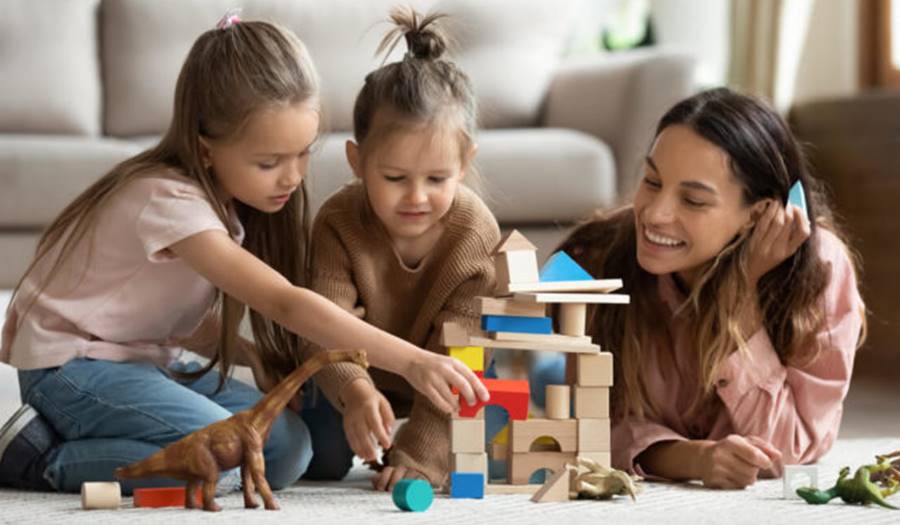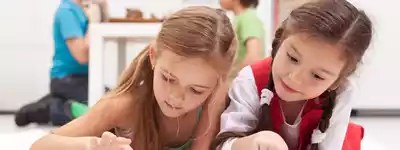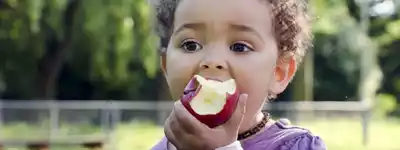
How Play Encourages Childhood Development
3/15/2021
Play and childhood are synonymous with each other. But did you know is more than just fun It is vitally important to children’s development! It works your child’s brain and body. Despite the importance of play, it is getting replaced by more and more screen time. Screen time does not give children the practice they need to help build skills important for meeting developmental milestones and interacting with the world.
THE IMPORTANCE OF PLAY
Playing, whether with parents, peers or independent play, helps children build skills they need to navigate their world. Play helps to:
• Build physical skills
• Builds social skills and social bonds
• Builds cognitive skill
• Builds literacy skills
• Builds language and math skills
• Helps children cope with stress
•Improves planning and organizing
• Helps children to learn about and manage emotions
Children should have opportunities to play every day. And not all play needs to be facilitated by a parent or take place with a peer, independent play is also important. If your child is playing independently, we recommend letting them play and not interrupting unless necessary. We also recommend making sure your child is exposed to all four types of play: toy, physical, outdoor, and pretend play.
TOY PLAY
Toy or object play is the manipulating of toys or non-toy objects (such as a wooden spoon). Toy play allows a child to experiment, learn more about objects, and work on sensory, fine, and gross motor skills, Toys also help develop abstract though.
The best toys are ones that have multiple ways to be used. This means the child plays WITH the toy, the toy does not play FOR the child. Traditional toys (suggestions HERE) are the best toys for development. Simple toys are better than complex toys. We’ve all seen the child that plays with the box the toy came in with more than the toy itself! Toys like blocks, puzzles, dolls, animals, and people figures are excellent toys that help boost imaginative play and problem-solving skills. Balls, push or pull toys, and ride on toys, help with physical development.
You do not need to provide your child with a room full of toys. Research shows that less is more! Children who have access to 4 toys play more than when they have 16 toys in front of them. Children who are offered a few toys at a time showed better cognitive development, were able to play for longer periods of time, and were able to play with toys in different ways. A child who has too many toy options have reduced time of play, reduced quality of play, and are more easily distracted. If your child is overwhelmed by toys, we recommend using a toy rotation to limit the number of toys offered at a time. This limits what is available and keeps play exciting.
PHYSICAL PLAY
Physical play includes tummy time, building blocks, going down a slide, pushing a cart, or using a ride on toy. As kids get older, it includes playing at a playground, hopping skipping, swimming, and riding a bike. Physical type play helps build gross motor skills and helps with motor planning. It improves strength and balance. It also helps build emotional intelligence and builds confidence.
OUTDOOR PLAY
Outdoor play, including playing in sand, snow or grass, on a playground or in nature, allows children to use all their senses to play. Children who play outside have more advance motor skills, improved muscle strength. They work on balance and spatial awareness. They also have greater self-awareness and communication skills. They build social relationships and develop independence. Outdoor play also helps brain development, organization and decision making.
PRETEND PLAY
Pretend play includes dressing up, having a tea party, or playing house or doctor, or imitating everyday actions like talking on the phone. Pretend play is a very important type of play we see emerge around 18 months, generally by imitating everyday life. For example, your child may pretend to talk on the phone or imitate you cleaning. Pretend play is a marker of social and emotional development. It shows a shift from thinking about self to thinking about others. It helps a child grow emotionally. They have to work on the “what ifs” of life, think about events and possible outcomes. It also promotes self-control and emotional regulation. It helps children work on communication and language skills including negotiation. It also helps encourage creativity.
Around age 2, pretend play matures. They may pretend with an object that is not a phone. This I called symbolic pretend play. They start taking care of dolls, playing and acting out with figurines, or playing dress up. They even start to “play act” themselves: they may pretend to be asleep or pretend to be a baby. By age 4, their pretend play actively involves others, and they will be able to narrate through the pretend play.

HOW TO FACILITATE PLAY
We now know how important play is and what type of play is important. We need to make sure we give children a lot of independent play time where they self-direct play and play on their own. This is when some of the best development happens! But we also want to play with our children. What can you actually do as a parent to provide play opportunities to your child both self-directed or playing with them. Let’s look by age at things you can easily do at home.
NEWBORNS
Newborns spend most of their time eating and sleeping. But during those brief awake times you can start to incorporate play. At this stage play is simple. Making eye contact with your baby, imitating faces they make, or smiling back at them are great ways to play and interact with your newborn. Infants also love if you talk or sing. When you sing to them, they are more likely to calm and stay calm for longer stretches versus just talking!
Time on the floor is also play time. This includes back play such as lying on a play mat, practicing side lying while looking at you, or working on tummy time for short periods of time. To keep their interest during floor time, you can talk to them, sing, show them a rattle or show them high contrast picture. This is also a great time to read to them. Massage during floor time or after a bath can also be a part of play for a newborn.
TWO TO FOUR MONTHS OLD
At this age, babies are starting to become more aware of their world and increasingly want to interact with the world. They love staring at you and having a “conversation” back and forth, blowing bubbles with spit, or trying to imitate you sticking out your tongue. They enjoy listening to you voice whether you are reading or singing, Music and dancing can be a fun activity, especially if your baby is having a grumpy day!
Babies are building strength in their necks and can hold their head up for longer periods of time. To help facilitate this, they need lots of time on in an open area to work on tummy, back, and side play to help build arm and core muscles important for rolling, crawling, eating, and speaking. As they approach 4 months of age, they start to reach for objects so playing on a mat or on your lap with an object slightly out of reach can help encourage that skill.
FIVE MONTHS OLD
Many of the same types of play encouraged for a younger baby are also still great activities you can do at this age. At this point, most babies have discovered their feet. Using toys that make noises or movement when they kick can be very entertaining. They also like to eat their own toes! This is important as it helps build core muscles needed in sitting and rolling. Tummy time, back time, and side lying time are still very important to practice daily. To help encourage your baby to stay on their tummy you can incorporate toys, mirrors, or books.
At this age, babies do not have object permanence meaning that if they can’t see an object, they do not know it is still there. This makes Peek-a-boo wildly entertaining. It often results in lots of giggles and belly laughs. But it is not just fun, it is important play to stimulate the brain, teach the element of surprise, stimulate visual tracking, encourage social skills, and building a sense of humor. And it helps your baby develop that object permanence!
Babies are also adept at bringing objects to their mouth at 5 months. Letting your baby mouth toys is an important way that they explore their world. They learn about objects and textures. It is also important for them to be able to bring their arms midline. This skill is essential for rolling, crawling, and walking. Mouthing toys is also important for helping a baby develop their mouth for feeding and speaking. Varying the texture of the toys they mouth helps your baby explore the world and prepares them for foods of different textures.
SIX TO NINE MONTHS OLD
Babies now enjoy being upright and they start working on moving. They sit unsupported and may even start crawling. It is important to give them lots of time to practice sitting in an open area with toys that are easily reached but also some toys that are out of reach. This helps encourage moving and builds up strong core muscles that are needed for fine motor skills, crawling, and walking.
Babies at this age still love peek-a-boo, especially as that object permanence develops. They love reading and exploring (and sometimes eating) books. They love music and may start trying to move or dance to the music. They love making noises and seeing your reaction to noises. This is a great time to incorporate hand games such as Patty Cake or Little Piggy into your play. You can sing simple songs or rhymes while working on patting and clapping.

NINE TO TWELVE MONTHS OLD
Your baby is growing into their own littler person! At this age they are exploring their world and we need to provide them with opportunities to safely do that. Most babies are on the move whether crawling, cruising or walking. Have a safe place for them to play is important but also giving them access to non-play areas such as a kitchen cabinet with pots, pans, or spoons they can play with and explore. Push carts or toys or ride on toys can help a child work on strength and gross motor skills.
Babies at this age love dumping things out. Have a container of items they can dump, put back in, and repeat can keep them entertained. Fine motor skills are starting to emerge so blocks and stacking toys are popular at this age. They also like playing with different textures and exploring things with their hands. This often includes food making mealtime very messy. Playing with textures isn’t just about food, it can also include sand, water, and grass.
Your baby will also enjoy reading, dancing, and singing at this age. They love to learn about their world so take walks and describe what you see. Don’t be afraid to narrate your day!
TWELVE TO EIGHTEEN MONTHS OLD
You officially have a toddler! Toddlers are busy and learning so much every day. They are working hard on gross motor skills such as walking, running, climbing, and throwing. They are also working on language skills. They love learning about cause and effect, gravity (throwing cups or food onto the floor), and they love to mimic others. They are fiercely independent at this age and like to try to do thing on their own.
Again, giving children time to explore in a safe environment is essential to learning and growth at this age. Allow opportunities for walking and climbing not only inside but outside. Walking on grass versus sand versus a dirt path helps a child build strength and balance. They also love exploring playgrounds, using slides, and being pushed in a swing.
Stacking toys, blocks, and items they can dump are still very popular and continue to help your child with visual-spatial skills, fine motor skills, and balance. Toddlers also start to show interest in dolls, trucks, and other imaginary play type toys. This is also an age where they really enjoy reading. They like to read the same book over and over, but don’t discourage this, even if you are bored. Repetition boost brain power!
Messy play is also important at this age. It’s sometimes hard as a parent to encourage this play, but it is so important for sensory development as well as fine motor development. Water play, playing in a container filled with rice or sand or snow, or playing with sticks and leaves help your child explore their world. Allowing your child to play with food, finger paint, and explore clay and playdough are other great options. And allowing play with forks, spoons, crayons, shape sorters and puzzles all help develop fine motor skills.
Reading, singing, rhyming, and talking are all important parts of play that help your child develop language skills and early literacy skills. Your toddler may be able to start imitating your singing or making the hand motions associated with a song.
EIGHTEEN MONTHS OLD TO TWO YEARS OLD
Your toddler is changing every day. They continue to need and want to explore their world. They start to show preferences in toys or type of toys and may have particular interests. They love making people laugh and have quite the personality. They are learning about acceptable behavior so may push limits and ignore you when you tell them no.
Your child will continue to enjoy the activities mentioned for 12 to 18 months old. Continue to offer your child safe areas to explore both inside and outside and allow them to challenge themselves. Allowing toys that don’t have a set purpose such as blocks allow your child to be creative with their play.
Pretend play starts around this time. You can help facilitate that by including your child in your normal household activities such as cooking, cleaning, and interacting with others. They model what they see so the more you expose them to, the more options they have available to their imagination.
Their fine motor skills are improving so continue to allow messy play as well as play with writing tools and smaller toys. Toys such as puzzles or toys that have tasks, such as latches, buttons, or zippers, can help improve those fine motor skills as well as hand eye coordination.
And as always read, sing and talk to your child. This is a huge time for language development. Your toddler will go from having a few words to speaking in short sentences! For ideas on how to help your child develop language during this time, please see our blog on speech development.
TWO TO FOUR YEARS OLD
This is an important time for social and emotional development. Your child learns many of these skills by pushing boundaries and pushing “buttons”. They are looking for boundaries because these boundaries make them feel safe and secure. They also teach them about social norms.
They love to play dress up at this age. Dress up is very important play. It helps build emotional and social development, helps a child with empathy, helps them to learn about the world, builds their verbal skills, increases confidence, increases impulse control, stretches memory skills, and helps them think creatively. When they play dress up with friends, they learn how to share, how to negotiate, how to build relationships, and how to communicate with others.
Your child will be very curious at this age. They want to learn more about their world and now have the language skills to express this. They may ask a lot of why questions (thank goodness for Google, I’m not sure how our parents made it through this stage). They want to know the how’s and what ifs. They love learning and are interested in colors and shapes. Reading can help build language and literacy skills but can also open the world to different people, places, cultures and ideas. Time with peers is also important. Your child starts to build friendships whether at school, at the playground, or during play dates.
Your child is also becoming more coordinated at this age. They will become more daring at the playground and will be able to handle new challenges. They may start riding a scooter or a tricycle. They can jump, walk on tip toes, and start to run faster. Outdoor time continues to be important for development but is also important for happiness! Research actually shows that children who play outside daily are happier overall! They also sleep better!
Children also continue to refine their fine motor skills. They love building, using larger Lego style blocks, “fixing” trucks and dressing up dolls. They also love creating art. Give your child play time with different material such as markers, crayons, clay, and paint. Also puzzles can get more intricate at this age and include more pieces.
FOUR YEARS OLD AND OLDER
School age children continue to learn through play. Gross motor skills continue to be refined. Your child may be riding a bike, able to swim, and start playing sports. They spend time hopping, swinging, dancing and climbing.
Children love to sing and dance at this age. Songs and rhyme continue to build early literacy skills. Children also love reading. They have favorite books and may have books memorized. They enjoy both fiction and non-fiction text.
Their imaginary play includes role playing and becomes more complex. It continues to help children work on social dynamics. They continue to work on building friendships requiring both communication skills and empathy. They are working hard learning to express and manage emotions all of which can be see with pretend play.
Children also enjoy board or card games at this age. They are able to handle more complex play that includes strategy! They are working on cognitive skills, fine motor skills, and social skills. They learn about taking turns. They have to manage their emotions if they don’t win. Some games work on counting, numbers, or colors or early literacy skills.
Children also make huge strides with fine motor skills. They are able to draw shapes, a person, and write letters. They also have learned to use scissors. They can create art and tell a story about their art and explain how and why they created it.
Children are amazing. In a few short years they learn so much about the world around them and go from sleepy newborns to children who read, write, play sports and maintain friendships. We don’t have to sit and “teach” our children these skills, they learn it all through play! Daily play will help your child growth and thrive in a way that screen time will never be able to do! Allow your child has the opportunity to play every day and include all four play types in their playing.
Children’s Health Care of Newburyport, Massachusetts and Haverhill, Massachusetts is a pediatric healthcare practice providing care for families across the North Shore, Merrimack Valley, southern New Hampshire, and the Seacoast regions. The Children’s Health Care team includes pediatricians and pediatric nurse practitioners who provide comprehensive pediatric health care for children, including newborns, toddlers, school aged children, adolescents, and young adults. Our child-centered and family-focused approach covers preventative and urgent care, immunizations, and specialist referrals. Our services include an on-site pediatric nutritionist, special needs care coordinator, and social workers. We also have walk-in appointments available at all of our locations for acute sick visits. Please visit chcmass.com where you will find information about our pediatric doctors, nurse practitioners, as well as our hours and services.
Disclaimer: this health information is for educational purposes only. You, the reader, assume full responsibility for how you choose to use it.








